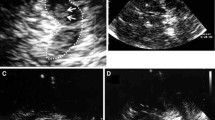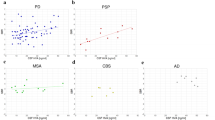Abstract
Dopaminergic dysfunction is thought to play a pivotal role in human immunodeficiency virus (HIV)-related dementia. Decreased dopamine (DA) levels in the cerebrospinal fluid (CSF) and neuronal loss in the substantia nigra (SN) have been reported in HIV-infected patients, suggesting nigrostriatal damage. Structural changes detectable as hyperechogenicity in transcranial ultrasound (TCS) scans of the SN have been reported in patients with Parkinson’s disease (PD) and other neurological conditions. In this study, we assessed the echomorphology of the SN in 40 HIV-positive patients compared to 40 age- and sex-matched healthy controls and correlated these findings with CSF levels of DA and the metabolites homovanillic acid (HVA) and 3,4-dihydroxy phenylacetic acid (DOPAC) and with neuropsychologic performance. We observed that the SN of HIV-infected patients was hyperechogenic relative to that of controls (0.07 ± 0.05 vs. 0.04 ± 0.07 cm2; mean ± SEM; P < 0.001) and that this SN hyperechogenicity was correlated with decreased DA levels in the CSF, decreased CD4 cell count, and an impaired performance in the psychopathology assessment scale (AMDP) subtest for drive and psychomobility. An association to CDC stage, duration of HIV infection, or presence of HIV dementia was not observed. Our results indicate changes in the nigrostriatal system in HIV-infected patients that are detectable as hyperechogenic SN precede prominent extrapyramidal symptoms and cognitive dysfunction.


Similar content being viewed by others
References
Arendt G, Nolting T, Frisch C, Husstedt IW, Gregor N, Koutsilieri E, Maschke M, Angerer A, Obermann M, Neuen-Jacob E, Adams O, Loeffert S, Riederer P, ter Meulen V, Sopper S (2007) Intrathecal viral replication and cerebral deficits in different stages of human immunodeficiency virus disease. J Neurovirol 13:225–232
Bagetta G, Corasaniti MT, Aloe L, Berliocchi L, Costa N, Finazzi-Agro A, Nistico G (1996) Intracerebral injection of human immunodeficiency virus type 1 coat protein gp120 differentially affects the expression of nerve growth factor and nitric oxide synthase in the hippocampus of rat. Proc Natl Acad Sci USA 93:928–933
Becker G, Seufert J, Bogdahn U, Reichmann H, Reiners K (1995) Degeneration of substantia nigra in chronic Parkinson’s disease visualized by transcranial color-coded real-time sonography. Neurology 45:182–184
Behnke S, Berg D, Naumann M, Becker G (2005) Differentiation of Parkinson’s disease and atypical parkinsonian syndromes by transcranial ultrasound. J Neurol Neurosurg Psychiatry 76:423–425
Behnke S, Double KL, Duma S, Broe GA, Guenther V, Becker G, Halliday GM (2007) Substantia nigra echomorphology in the healthy very old: correlation with motor slowing. Neuroimage 34:1054–1059
Bennett BA, Rusyniak DE, Hollingsworth CK (1995) HIV-1 gp120-induced neurotoxicity to midbrain dopamine cultures. Brain Res 705:168–176
Berg D, Becker G, Zeiler B, Tucha O, Hofmann E, Preier M, Benz P, Jost W, Reiners K, Lange KW (1999) Vulnerability of the nigrostriatal system as detected by transcranial ultrasound. Neurology 53:1026–1031
Berg D, Jabs B, Merschdorf U, Beckmann H, Becker G (2001a) Echogenicity of substantia nigra determined by transcranial ultrasound correlates with severity of parkinsonian symptoms induced by neuroleptic therapy. Biol Psychiatry 50:463–467
Berg D, Siefker C, Becker G (2001b) Echogenicity of the substantia nigra in Parkinson’s disease and its relation to clinical findings. J Neurol 248:684–689
Berg D, Merz B, Reiners K, Naumann M, Becker G (2005) Five-year follow-up study of hyperechogenicity of the substantia nigra in Parkinson’s disease. Mov Disord 20:383–385
Berger JR, Arendt G (2000) HIV dementia: the role of the basal ganglia and dopaminergic systems. J Psychopharmacol 14:214–221
Berger JR, Kumar M, Kumar A, Fernandez JB, Levin B (1994) Cerebrospinal fluid dopamine in HIV-1 infection. AIDS 8:67–71
Biard-Piechaczyk M, Robert-Hebmann V, Richard V, Roland J, Hipskind RA, Devaux C (2000) Caspase-dependent apoptosis of cells expressing the chemokine receptor CXCR4 is induced by cell membrane-associated human immunodeficiency virus type 1 envelope glycoprotein (gp120). Virology 268:329–344
di Rocco A, Bottiglieri T, Dorfman D, Werner P, Morrison C, Simpson D (2000) Decreased homovanilic acid in cerebrospinal fluid correlates with impaired neuropsychologic function in HIV-1-infected patients. Clin Neuropharmacol 23:190–194
Hriso E, Kuhn T, Masdeu JC, Grundman M (1991) Extrapyramidal symptoms due to dopamine-blocking agents in patients with AIDS encephalopathy. Am J Psychiatry 148:1558–1561
Itoh K, Mehraein P, Weis S (2000) Neuronal damage of the substantia nigra in HIV-1 infected brains. Acta Neuropathol 99:376–384
Koutsilieri E, Gotz ME, Sopper S, Stahl-Hennig C, Czub M, ter Meulen V, Riederer P (1997) Monoamine metabolite levels in CSF of SIV-infected rhesus monkeys (Macaca mulatta). Neuroreport 8:3833–3836
Kruman II, Nath A, Mattson MP (1998) HIV-1 protein Tat induces apoptosis of hippocampal neurons by a mechanism involving caspase activation, calcium overload, and oxidative stress. Exp Neurol 154:276–288
Larsson M, Hagberg L, Forsman A, Norkrans G (1991) Cerebrospinal fluid catecholamine metabolites in HIV-infected patients. J Neurosci Res 28:406–409
Meucci O, Fatatis A, Simen AA, Bushell TJ, Gray PW, Miller RJ (1998) Chemokines regulate hippocampal neuronal signaling and gp120 neurotoxicity. Proc Natl Acad Sci USA 95:14500–14505
Nath A, Anderson C, Jones M, Maragos W, Booze R, Mactutus C, Bell J, Hauser KF, Mattson M (2000) Neurotoxicity and dysfunction of dopaminergic systems associated with AIDS dementia. J Psychopharmacol 14:222–227
Nath A, Psooy K, Martin C, Knudsen B, Magnuson DS, Haughey N, Geiger JD (1996) Identification of a human immunodeficiency virus type 1 Tat epitope that is neuroexcitatory and neurotoxic. J Virol 70:1475–1480
Postert T, Eyding J, Berg D, Przuntek H, Becker G, Finger M, Schols L (2004) Transcranial sonography in spinocerebellar ataxia type 3. J Neural Transm Suppl 68:123–133
Postert T, Lack B, Kuhn W, Jergas M, Andrich J, Braun B, Przuntek H, Sprengelmeyer R, Agelink M, Buttner T (1999) Basal ganglia alterations and brain atrophy in Huntington’s disease depicted by transcranial real time sonography. J Neurol Neurosurg Psychiatry 67:457–462
Reyes MG, Faraldi F, Senseng CS, Flowers C, Fariello R (1991) Nigral degeneration in acquired immune deficiency syndrome (AIDS). Acta Neuropathol 82:39–44
Schmidauer C, Sojer M, Seppi K, Stockner H, Hogl B, Biedermann B, Brandauer E, Peralta CM, Wenning GK, Poewe W (2005) Transcranial ultrasound shows nigral hypoechogenicity in restless legs syndrome. Ann Neurol 58:630–634
Spiegel J, Hellwig D, Mollers MO, Behnke S, Jost W, Fassbender K, Samnick S, Dillmann U, Becker G, Kirsch CM (2006) Transcranial sonography and [123I]FP-CIT SPECT disclose complementary aspects of Parkinson’s disease. Brain 129:1188–1193
Walter U, Hoeppner J, Prudente-Morrissey L, Horowski S, Herpertz SC, Benecke R (2007) Parkinson’s disease-like midbrain sonography abnormalities are frequent in depressive disorders. Brain 130:1799–1807
Conflict of interest statement
The authors report no conflicts of interests.
Author information
Authors and Affiliations
Consortia
Corresponding author
Rights and permissions
About this article
Cite this article
Obermann, M., Küper, M., Kastrup, O. et al. Substantia nigra hyperechogenicity and CSF dopamine depletion in HIV. J Neurol 256, 948–953 (2009). https://doi.org/10.1007/s00415-009-5052-3
Received:
Revised:
Accepted:
Published:
Issue Date:
DOI: https://doi.org/10.1007/s00415-009-5052-3




